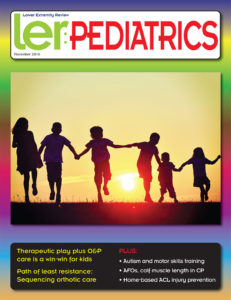Editor Message
 Making it personal
Making it personal
Personalized medicine, holistic care, and patient-centered management can all imply slightly different things, but beneath the differences one central tenet is the same—the importance of tailoring treatment to individual patients’ unique conditions, needs, and goals.
In this issue several articles discuss some of the varied ways in which lower extremity practitioners are taking an individualized approach to orthotic management of young patients, who are undergoing rapid physical changes, developing interests, and facing other childhood challenges.
Karl Barner, CPO, LPO, for example, notes in “Therapeutic play plus O&P care is a win-win for kids” (page 11), that attending some of his patient’s sports events and watching them in those environments helps him better understand their reality—and perhaps adapt their braces or orthoses for a better fit.
In “Path of least resistance: sequencing orthotic care” (page 17), experts note that how restrictive a device needs to be can depend on factors other than a child’s specific diagnosis, such as how much follow-up or physical therapy their personal situation will allow. If compliance or follow-up is likely to be limited, for example, keeping that child safe might mean heavier bracing makes more sense.
And, in “AFO effects on gastrocnemius underscore heterogeneity of CP” (page 7), the author of the study reviewed says her research highlights a need for adjustable, adaptive devices that make use of flexible design, smart sensors, and machine learning algorithms so they can change as the needs of the wearer change.
Whether it’s delving into a child’s personality to discover why they aren’t wearing their brace or getting parental feedback to understand how a child is functioning in a real-world setting, lower extremity practitioners have many opportunities to get to know their patients as individuals—and to adjust their care accordingly. Doing so can mean better outcomes—and happier, more active patients.
By Emily Delzell, Senior Editor
News
- Early motor skills training in ASD improves locomotion, socialization
- AFO effects on gastrocnemius underscore heterogeneity of CP
- Home-based ACL injury prevention program fails the compliance test

